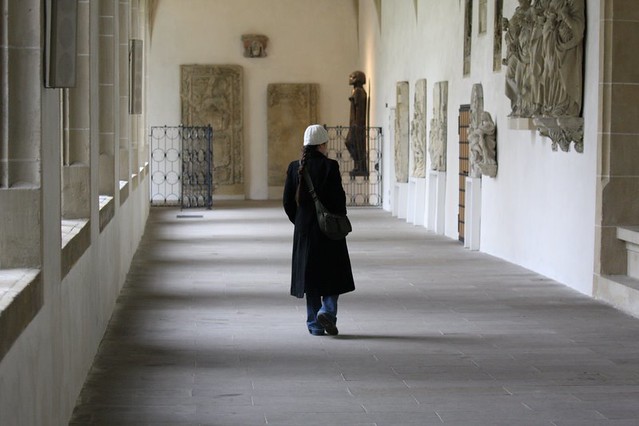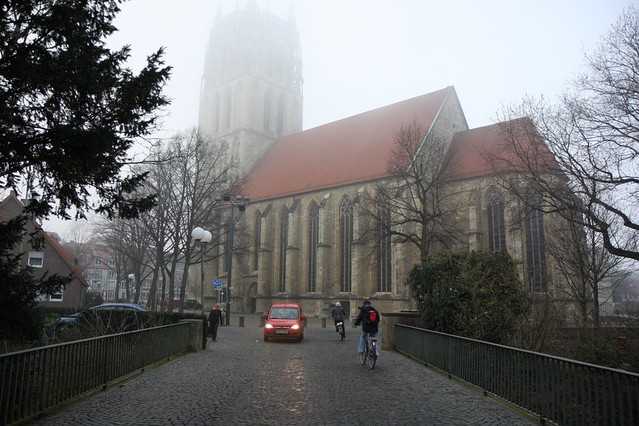
It's hard to believe we only have another week here before we begin our grand adventure on the road. Udo said that if he doesn't find a tenant by March 1 we can stay a little longer, but it's not looking very likely. He said he's already turned one person down and a young couple came over to view the flat yesterday.
We've pretty much stayed home since the Rhine tour, partly because we both have colds, partly because the weather isn't nice anymore, but mostly because we have so much to do. We need to get shipping, packing and travel planning and I have a lot of stuff to wrap up on the website before I say goodbye to my desktop computer.
At least we have the car situation out of the way. We had long planned to do the Peugeot buy-back program, a really good deal based on some peculiarities of the French car tax system. It allows foreigners to use a brand-new car with full insurance for 17 days or more, which they then sell to a French owner for a reduced price. Somehow, everybody wins. But apparently we have been in the EU for so long that we are no longer considered foreign enough for this program and are disqualified!
Fortunately, we still managed to get a good deal on some kind of economy-sized Peugeot or Renault for three months. We have to pick it up in France, so we (or maybe just David) will take the train to Strasbourg this Tuesday to get it. There's lots of good stuff to see there, but we probably won't stay since we have so much to do to get ready. Hopefully we'll catch it in late summer as part of our France tour.
Münster
And before it gets too overdue, I should post some pictures and memories from our trip to the fine city of Münster in Westphalia (NW Germany), which we did a couple days before the Rhine castles. It was predicted to be another beautiful sunny day, so although it was foggy as we left in the morning, we figured it would "burn off" (ever the Oregonian optimists). Well, it never did.
We were socked in by near-freezing fog all day, which was so very cold and far from ideal for pictures. It also prevented us from seeing any of the Westphalian landscape on the way there, which is said to be flat and green like the Netherlands. But we still saw lots of good stuff and the blue sky did make a brief appearance in the late afternoon before the fog settled in again for the evening.

The cathedral and city of Münster were founded by a missionary-monk sent by Charlemagne to convert the Saxons in 794. The city name comes from that monastic settlement, and eventually became the general word in German (münster) and English (minster) for monastic missionary churches, such as Bern Münster and York Minster.

The cathedral is very cool and has lots of interesting bits. The first one is the Paradise Porch, which is chock-full of medieval sculptures.

In the center by the door are Christ and St. Paul (patron of the cathedral), and surrounding them are apostles taller than I am and tiny little figures keeping busy among vines. All of them date from 1225-35, just when Romanesque was starting to transition into Gothic.




Inside is a really unusual nave, with transepts at both ends and only two giant arches on either side instead of the usual six or so.


The main highlight of the interior is the astronomical clock, a beautiful creation made in 1540-43. It was made entirely in Münster by a team of iron workers, clock makers, painters and sculptors. It tells the time, the date, the day of the week, the sign of the zodiac, the position of the planets, the phase of the moon, the saints' days, and the dates of Easter from 1540 to 2071! It's a seriously impressive combination of art and science.






 The small cloisters were also nice, with lots on carvings on the walls and old tombs and such.
The small cloisters were also nice, with lots on carvings on the walls and old tombs and such.
Just off the cloisters of the cathedral is a new building housing the Treasury, which was very cool. We lingered in there for quite awhile, enjoying the warmth and hoping the fog would go away. Some highlights:



Next stop was the Town Hall, just down a short street from the cathedral. It is important because it was here that the Peace of Westphalia was signed in 1648. It was bombed in the war, but fully rebuilt.


We had to pay a small admission but we had it all to ourselves and were able to take pictures. They also piped in a narrative in English over the speakers while we were in there!

Down a nice cobble-stone street from the Town Hall is the Lambertikirche, a pretty 14th-century Gothic church.





We ended our long cold day in Münster by escaping indoors again, this time to the Westphalian Regional Museum just around the corner from the cathedral (not much walking is required in this city!). It's a nice modern building with artworks from medieval times to the present, including a large exhibition on a current modern artist. But we only had energy and interest for the Early Middle Ages section on the ground floor.
The good news is they let us take pictures, but the bad news is we had to sign a photography permit pledging we wouldn't use the photos for commercial purposes without permission. In case that includes publication on my blog and website, I've written them an e-mail for permission - no response yet.
There was some really good stuff in our "Mittelalter" section, including lots of miniature ivory reliefs, stained glass, manuscripts, murals, sculptures... We and the few other visitors were watched the entire time by attentive staff, presumably to make sure we didn't take out a hammer or spray paint at any point. I wondered if they'd been trained in slide tackles for such an event. But I digress.
My favorite exhibit was a beautiful set of wood-carved Zodiacs and Labors of the Months from a Westphalian convent. I've only recently discovered this interesting theme in medieval art but have taken quite a liking to it.
By the time our sore feet emerged from the museum it was getting dark. We thought traffic might be bad at rush hour in the fog, so we looked around for a place to have dinner. Our walking route took us past this fine church with a huge tower, but we didn't go in.
We walked for several blocks in the cold fog, but all we came across was an expensive French restaurant and really cheap kebab joint. So we just went home, made a stop for snacks along the Autobahn, and traffic turned out to be fine.
loading

